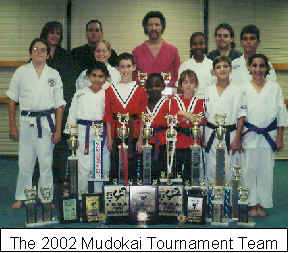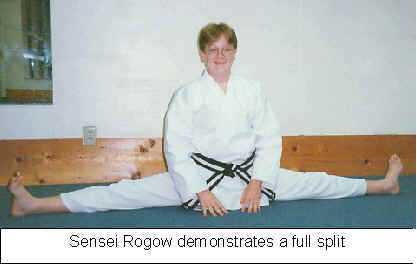
Training Opportunities for Students:
Learn, Practice and Perform with Excellence
The in-school Shiai that recently took place in December was an opportunity for students to perform their skills in the same manner as they would have to at a competition. For any endeavor there are always three different phases within which our skills must be honed. The first of these involves learning; in martial arts this is often the most exciting phase for students. This is where we get to do things we have never done before and try out new punches, kicks and blocks for the first time. Following this learning phase we move on to practice, which involves advancing our skill through repetition. Most instructors believe that 4000 repetitions must be correctly performed for a technique to be thoroughly drilled into the body. This part of training often doesn’t seem so much fun and students can become bored if they do not focus on making every repetition perfect. The third phase is performance and this is where tournaments, the Shiai, grading tests, or demonstrations come in. All of these are opportunities that we have to show and demonstrate what we have learned and practiced. If we have drilled on all of our techniques thoroughly, and know that we are in the best condition we can achieve, we will be relaxed and optimistic in regard to our performance skills. On the other hand, if we are going to try to perform something we are still learning, or something that we have not practiced recently, we will find ourselves less confident, more stressed out and less likely to turn in an excellent performance. One of the main benefits of performance is that it motivates us to practice. Everybody wants to look good and no one wants to be embarrassed by a mediocre performance, which is why, if we know a performance will be required of us, we will tend to train harder in preparation for it.

For most students at the dojo the least demanding performance is probably represented by a Shiai. The atmosphere is supportive; students are surrounded with several Sensei there to help them do the best they can. Regular rank grading would be the second most comfortable situation, because although we are being tested, we know that we have earned three red stripes in preparation for the test, been checked off by the Sensei on all our techniques and only have to perform the material we’ve been practicing.
Demonstrations, especially when conducted in front of a large group of strangers, can be quite stressful. One way to alleviate that stress is with rehearsal prior to the demonstration, so that we know exactly what we will be doing and have practiced our performance over and over again in the dojo prior to going onstage. For many people, attending a tournament is so stressful an idea that they never do it. This is a shame because training for a tournament and working really hard to gain the high level of skill necessary to present ourselves well in front of a panel of Black Belt judges we don’t know, can bring out the very best in a martial artist. Certainly most of the top students at UKC have tournament experience and some of them have excelled as competitors. To be confident at a tournament a student must have practiced the skills they are planning to demonstrate thousands of times more than an average student. Many students who perform Kata at tournaments have practiced and performed the same form for two or three years before they begin winning with it. While that intense practice takes a lot of discipline, it also produces excellence as a result. Similarly,
to win in a fighting division, students would need to spar every week to maintain and improve their skills.
The most stressful situation we can ever find ourselves in as martial artists is one where we actually have to defend ourselves. Should an incident occur that requires us to fight for our lives, we must keep our techniques simple and trust that the training that we have been putting in will come out. Under circumstances of this kind, we will feel the most confident if we have practiced really hard for a long time. Any student who is training with self– defense in mind would do well to take the opportunity to go beyond the performance level mandated by the grading curriculum by utilizing the opportunity to participate in Shiai and tournaments. Coping with the additional levels of stress that these performances put you under can lead to a real boost in competence and confidence that will carry over to a self -defense situation should that ever arise. It’s all a preparation for real life.
Sensei Robert H. Mason © 2002
A Word About Warm Ups
Warm ups, the stretching that all students participate in at the beginning of each lesson, is an important part of training. All students should endeavor to arrive in plenty of time for class so that they can get the benefit of a complete warm up. Students need to pay close attention to whoever leads the warm ups and follow their direction so as to be properly prepared for class. Unnecessary talking and socializing is distracting and dilutes the dojo atmosphere which is necessary for proper training. Just as bowing when entering or leaving the dojo sets the tone of courtesy and consciousness that martial arts represents, so each action performed in class either leads toward greater focus or away from concentration to an unfocussed state. Making the right kind of effort in warm ups is a great way to start the class with a proper training attitude.

Sloppy attitudes make for sloppy warm ups which lead to sloppy techniques.
Check out the bulletin board in the Student Waiting Area to view the Splits Club photos. If you cannot yet qualify for the splits club you have a lot of work to do to achieve your potential range of flexibility. If you are already in the splits club then you must stretch to keep your muscles limber.
Sensei Robert Heale Mason © 2003
MARTIAL ARTS - East meets West
In America, a society including many different cultures, it is interesting to notice what happens when different, perhaps conflicting, conventions meet. This may happen when people speak different languages, have different religions, different diets, different philosophies or rules of courtesy, etc. We can see that in the U.S.A. sometimes these differences are worked out and sometimes not. Martial Arts in America has included a blending of these differences. Karate, the way of the empty hand, was originally developed in the East (Okinawa), hence many of the customs in karate reflect the structure and conventions of the East. These include bowing when entering or leaving the dojo (training hall), addressing instructors as "Sensei" and "bowing in" and "bowing out" of the class. Not asking for promotions, belts or stripes, but rather training patiently and with concentration, having excellence as a goal and allowing the belts to come in due course, forms part of the Eastern ideal.
Training in Karate rather than "taking" karate is also an Eastern rather than Western attitude. Taking karate is a Western concept (being more focused on stripes, trophies and promotions) and actually implies that the student is taking something from the instructor, rather than training with the instructor. Training in karate is an Eastern concept (being focused on the courtesy, discipline, respect and character building that the martial arts can provide) and better describes the relationship between the Sensei and the student. Understanding that the purpose of training is best thought of as a mutual growth process will lead the student to seek the internal rewards that will bring long-term benefits. These benefits may include enhanced self-esteem, self-confidence and the development of a sense of personal presence. The short term external rewards of belts, trophies and promotions will not prove as valuable, nor be as profoundly felt, although they play an important role in short term motivation and intermediate goal setting. It is of course up to the student to choose how much value to place on each aspect of their Martial Arts training.
Sensei Robert Heale Mason © 1992